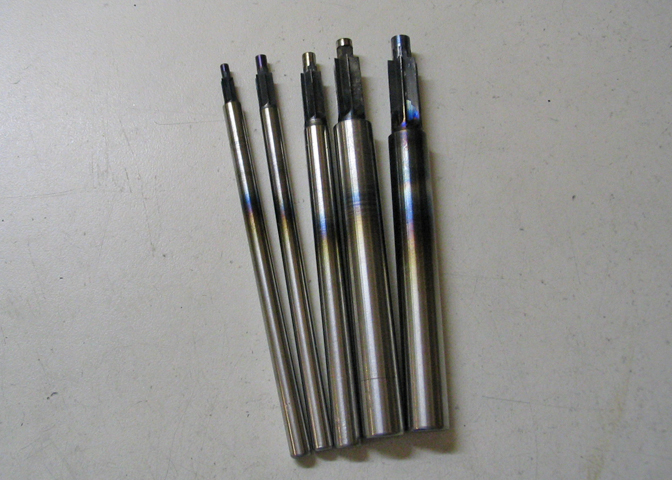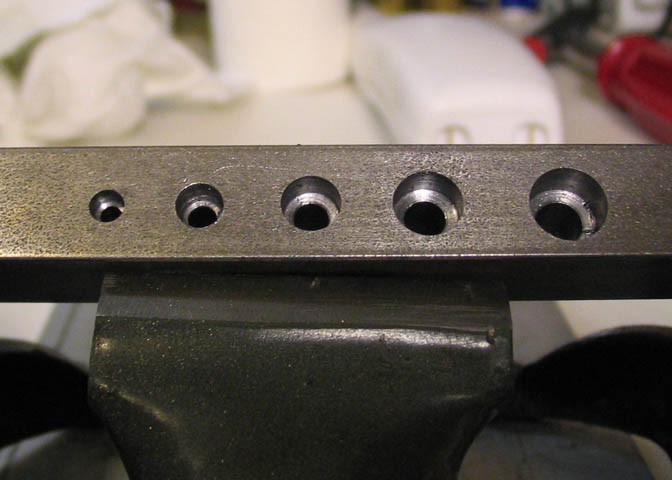Stew, thank you.
Joe D. A man after my own heart!
Well, I've gone from feeling crappy, up to just feeling a little cruddy, which is an improvement by
any measurement.
So, after messing up my cutter last time, I thought I should show it done up without any big goofs, and
maybe someone will find something useful.
Some of the members here know how to make such things well and proper. I know how to make
them so they work, but it may not be the best way to do it. It's
A way to do it, and a way that
gives you a functioning cutter.
There are a few basics, and if you get them right, your cutter will usually work.
1) you need the cutting edges, obviously
2) you need a place for chips to escape, (flutes)
3) you need a relief of some sort behind the cutting edge, (or the edge will just rub)
4) it usually helps if cutting edges trail the centerline of the cutter during rotation
5) I'm not a tool and die maker
This time, end mill on the right side of things, three cuts are made, just over 1/2 the diameter deep,
(see #4, above), and with a feed on the X that will barely let the end mill take a nick out of the pilot.
The material is W-1 drill rod. O-1 will work as well, and I think actually holds an edge a little better, but
it's not as handy to work with indoors.
The depth of cut part, "
just over 1/2 the diameter deep", refers to the cut as measured from the top
of the work piece down to where the cut ends. It needs to go just below the center line of the tool
blank. For this diameter, which is .375", I made the cuts .190" deep. You can use approximately
1% as your factor to figure how much over half the diameter you should go. It's a figure that
I know works for tools of diameters from 1/8" to 1/2". It may work for many other diameters. The
ones mentioned are in my actual experience.
That nick in the pilot is to make sure that what will be the cutting edge on the bottom of the cutter will
actually have an edge right up to the center of the pilot hole. Otherwise, it won't cut well right next to
the pilot hole.
Now I'm headed in the right direction, literally. Should have put a better finish on the larger diameter
when I turned up the blank, but this will still work fine. A better finish on the end would have left a
smoother finish at the bottom of the hole this cutter will make.
It's time to cut the clearances behind the cutting edges. The vise is slewed over about 7° to the
right. That's not a fixed number. Six to ten degrees would have been fine. Not too much of an angle
though, or there will be little support for the cutting edges.
The white arrow shows the edge that will do the cutting. Most of the material behind that has to be
backed off a bit, or the whole end of the cutter will just rub. That's the reason for setting the vise over
the 7 deg.
Then a small end mill is used to nibble away at the material behind the edge. I left about 1/32" of the
original edge intact. The brighter part behind the edge is the part that's been cut away. The part that
is removed, behind the cutting edge, has to be taken down right to the diameter of the pilot. It's okay
if you make a small flat spot on the pilot when doing this. Just use an end mill small enough so you
don't make a very large flat.
The white arrow points to a little nub that's left after the first relief cuts. That has to be removed yet. The red line is the cutting edge, just for reference.
Here, one of the nubs is about to be cut away. The point at the red arrow is where the last one has
just been removed. You can do what you want in the area behind the cutting edge, meaning, if you
have to cut into it a little to get rid of things like that nub, it's okay. Just don't mess up the cutting
edges, and it will work as it should.
Once this is done, the piece is hardened and tempered. I think that's been covered a number of times
on the forum, so won't repeat it unless someone asks.
After it's hard, the cutting edges are honed lightly just to get the burrs off and smarten up the cutting
edges. This is the only surface that was put to a stone. You need to use a hard, smooth Arkansas
stone for this kind of stuff. Not some grainy old whet stone.
Works like a charm. The pilot on the cutter is used to center the bearing support, and then the recess
is cut to hold the bearing. I ran it at 500 rpm and let it have it's own way on the down feed.
The last thing for today is to ream the other two arms on the supports.
I'm just showing another way to do things, here. I don't mean it's anything new, but might get someone
out of a spot for lack of tooling, or if you own a small milling machine.
I need to ream the last two pilot holes to 5/16", but don't have a collet that size to fit my mill, and if I
use a drill chuck, there's not room for it mounted up under the spindle.
Reamers have a center hole in the chucking end, so I turned up a center that would fit up the spindle,
and into a collet I have available. Then I can hand turn the reamer with a tapping handle, and while
feeding down the spindle, ream the hole true.
Last shot of these things, (I think!). Goodness knows, everyone's seen enough of them.
The bronze bearings set in the holes that were run through with the factory reamer. The two
ball bearings fit into the pockets that were bored with the shop made cutter.
If there are questions, ask away.
Thanks again everyone!
Dean
























